Stargazing

|
The Polar Constellations |

|
- Anybody recognize anything? (Someone will recognize the Big Dipper).
{Trace out the Big Dipper}.
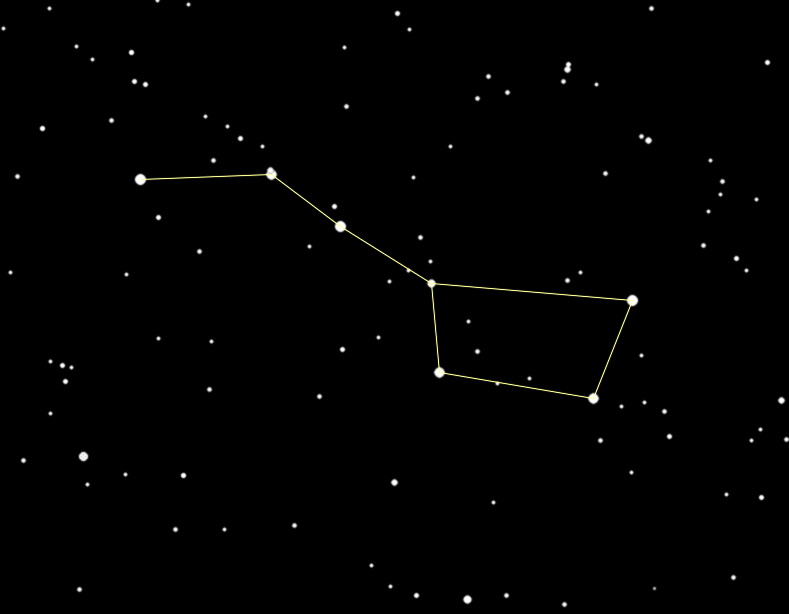
- It's really not a constellation, it's what's called an 'asterism', a highly recognizable part of a constellation. The full constellation actually is Ursa Major. {Trace out as much of Ursa Major as can be seen - later in the summer, the head & paws may not be visible.}
- However - if the tour is being given on a late spring night and the
Bear's paws can be seen then I also tell about the Three Leaps of the
Gazelle. This asterism is the sequence of three pairs of stars - normally
seen as the paws of Ursa Major. The story is that Leo the Lion startled
the gazelle, who in turn dashed off across a great celestial pond, leaving
a pair of stars marking each of the three leaps. Great story, great
asterism, and by July, pretty much lost to the horizon.
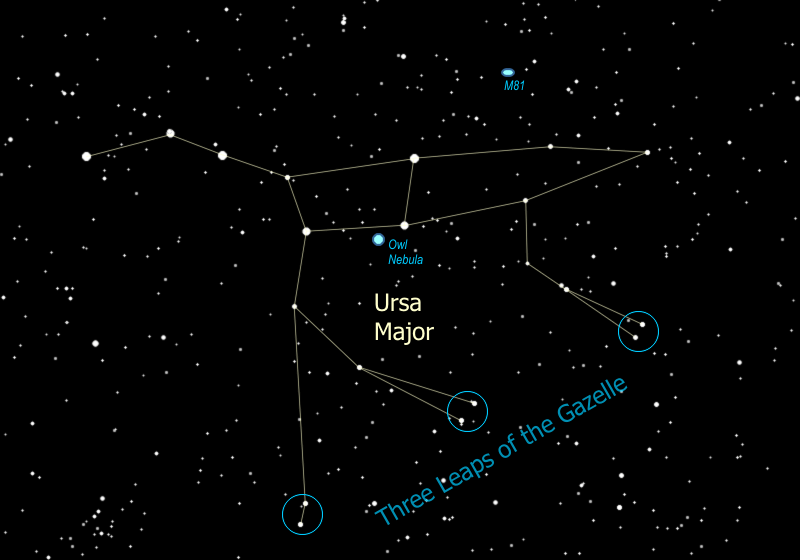
- The stars of the Big Dipper, with the exception of the tip of the handle and
the tip of the cup, are all moving in the same direction -- up and to the
left, or toward the Northwest. Because they're close together (all are about
75 light years away) and moving through space in the same direction at the
same speed, these stars are believed to have formed together from the same
original nebula. This group, known as the "Ursa Major Moving Group", is
officially the closest star cluster to us, and includes stars that are
scattered across the sky all the way from Boötes & Corona Borealis to
Auriga and Taurus. The reason they seem to be everywhere is because our
5 billion-year-old sun has drifted into the outer regions of this group of
500 million-year-old youngsters.
- We can find two of the best and brightest galaxies in the sky just above
the two stars that form the neck of the Bear -- they are M81 and its neighbor
M82. Use the binoculars and follow the line of the Bear's neck to a skinny
triangle, then go sideways to find a pair of stars that point the same
direction as the triangle does. Just a little farther you find M81, a faint
fuzzy spot just off the end of the arc of three faint stars nearby. See it?
This faint fuzzy spot is a huge galaxy, 4.5 MILLION light years away --
about twice as far away as the Andromeda galaxy. When I get this one in the
telescope you'll see that there are actually two galaxies there. The other
one is M82 and it is much flatter than M81. It is also much farther -- about
four times as far, 16 million light years away.
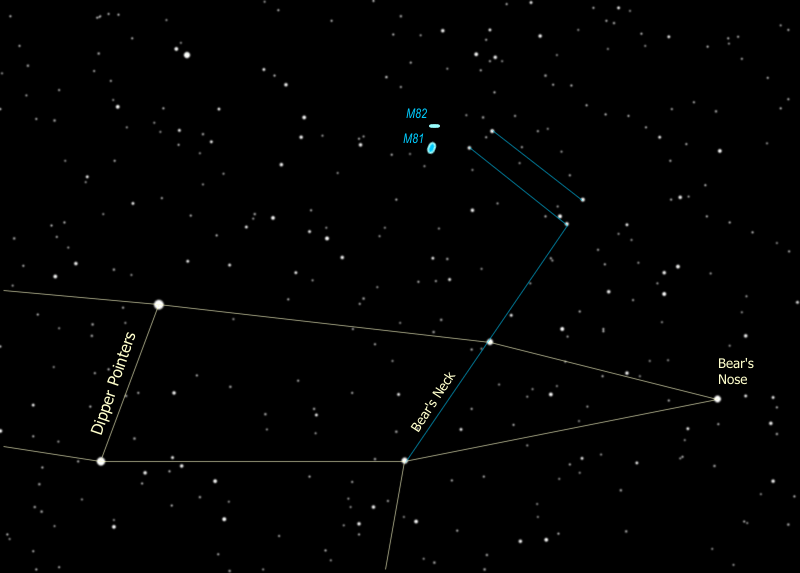
M81 is on the left, M82 is at the right 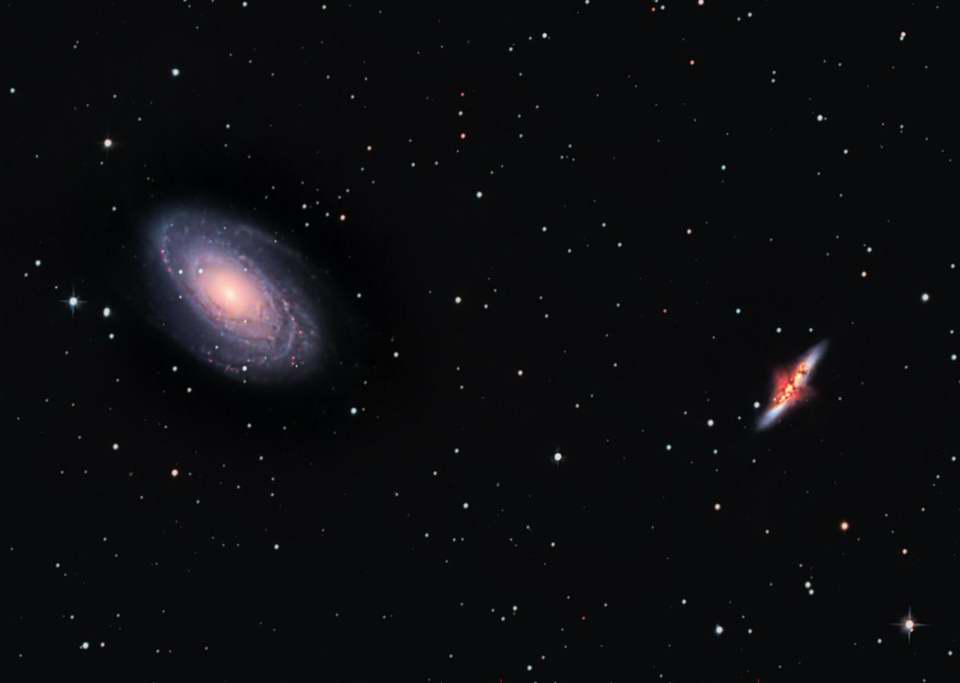
- The Big Dipper is a polar 'constellation' -- one that is very close to the
North Pole. If stars are close enough to the pole they never set below the
horizon and we can see them all year long. Can anyone spot the Pole Star?
How do you find it? That's right, the two stars at the front edge of the
cup are pointer stars and point to the North Star, whose actual name is
Polaris. Go up from the cup to find Polaris.
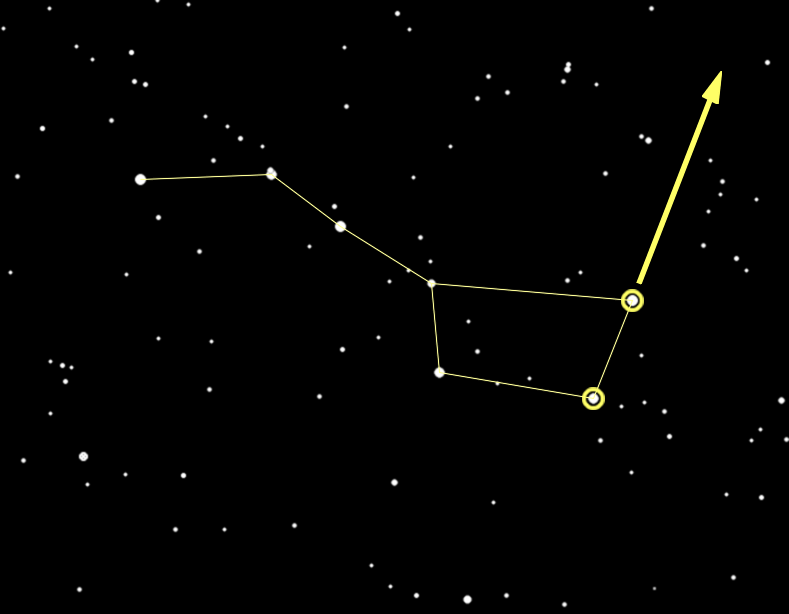
- Since the earth's north pole points to Polaris and the earth rotates around
its poles, all the constellations seem to rotate around Polaris, including
the Big Dipper. You can tell time using the Big Dipper -- it serves as a
24-hour clock.
Click on the little clock here
 for more information.
for more information. - Polaris is a part of the constellation Ursa Minor, more commonly known as
the Little Dipper. Polaris is at the tip of the handle. {Trace out
the Little Dipper.}
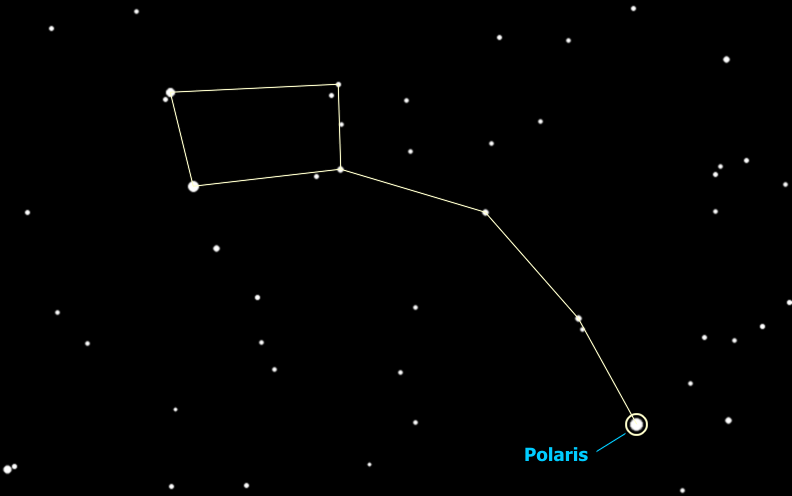
- The two most important Polar Constellations to recognize are the Big Dipper
and the Big W. The Big W is Cassiopeia - roughly on the opposite side of
Polaris from the Big Dipper -- {Trace out Cassiopeia}. Cassiopeia is a
Queen in her chair, and even though this isn't the "official" way to look
at her, I envision Cassiopeia's head at the left side of the "W", making
the figure like a lounge chair with a foot rest. This is how I learned it
as a kid, and it's very useful because you can easily find the North Star
by going "Up from the Seat" of Cassiopeia's chair, in similar manner to
going "Up from the Cup" of the Big Dipper. Since the Big W is on the
opposite side of the North Star, this gives you a way to find Polaris any
time of the year, even when the Dipper is below the tree line.
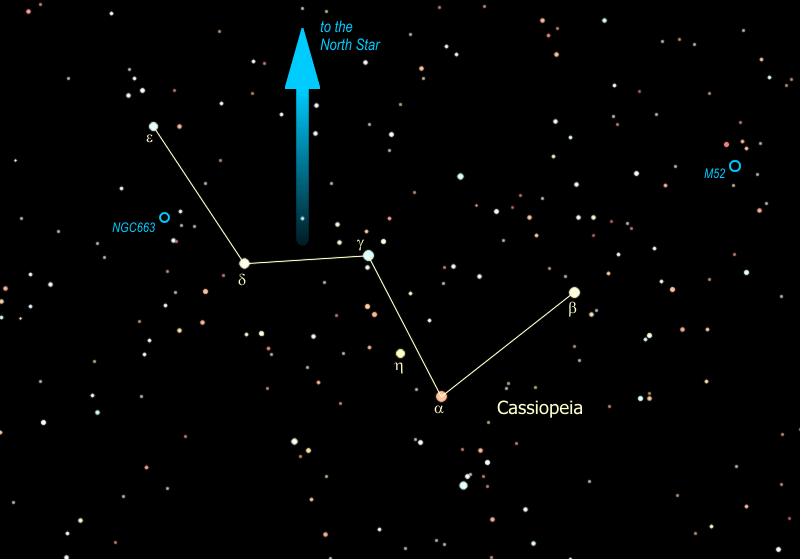
- Cassiopeia got herself in trouble with Poseidon boasting she was more
beautiful than the Nereids (sea nymphs) which leads to the story of
Andromeda and Perseus and involves no less than six constellations in the
sky (all fall constellations), the most involved in telling any
constellation legend. That's a story for another season.
- The constellation Cassiopeia lies right smack in
the path of the Milky Way, and is filled
with galactic clusters, also called open
clusters. There are several decent examples in Cassiopeia, like
Messier object #52, or "M52", one of many "M" objects named after a
catalog published in the late 1700's by the Frenchman Charles Messier.
Messier was a comet hunter of great renown who published a catalog of
fuzzy things that might be confused with comets. These ended up being
some of the most interesting objects in the sky. When you find M52 you
are looking at a "young"cluster of about 200 stars -- young means that
it is only about 100 million years old. The cluster is 10 light
years in diameter and 3000 light years away from us, which is why you
need the binoculars to see it.
Another interesting galactic cluster is NGC 663 (NGC stands for New General Catalog -- published in 1888 it's not really that new). This cluster lies about half way between the two stars on the flattened side of the "W", ε and δ Cassiopeiae. As you sweep the binoculars between the two stars, you will notice that NGC 663 is merely the largest and brightest of several clusters in this region. That may be because it is the closest, at about 3000 light years. The others in that area are 6000 - 8000 light years away. How many clusters can you spot between these two stars? You might be able to see as many as five, with NGC 663 at the center and the other four marking the corners of a diamond around it.
M52 - Note the little box of stars around the cluster NGC 663 - halfway down the left side of the "W" 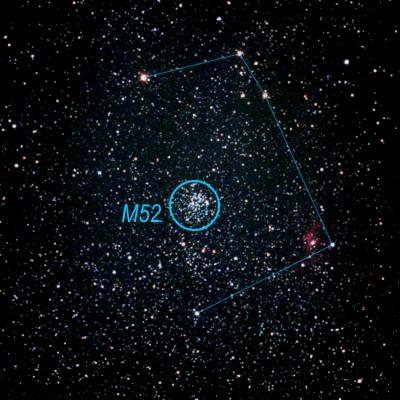
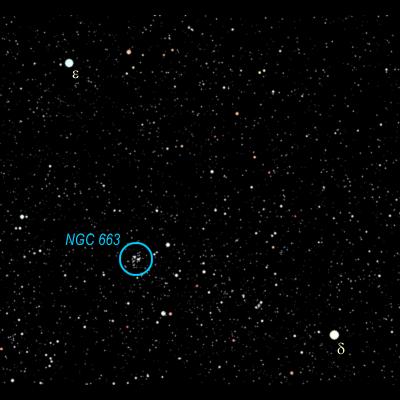
- So the Big Dipper points to the North Star -- it also points to other
important stars -- you follow the arc of the Dipper's handle and "arc
to Arcturus", then "spike to Spica" - two very important stars
that we will get to in a minute. So the three stars of the handle are
pointers as well.
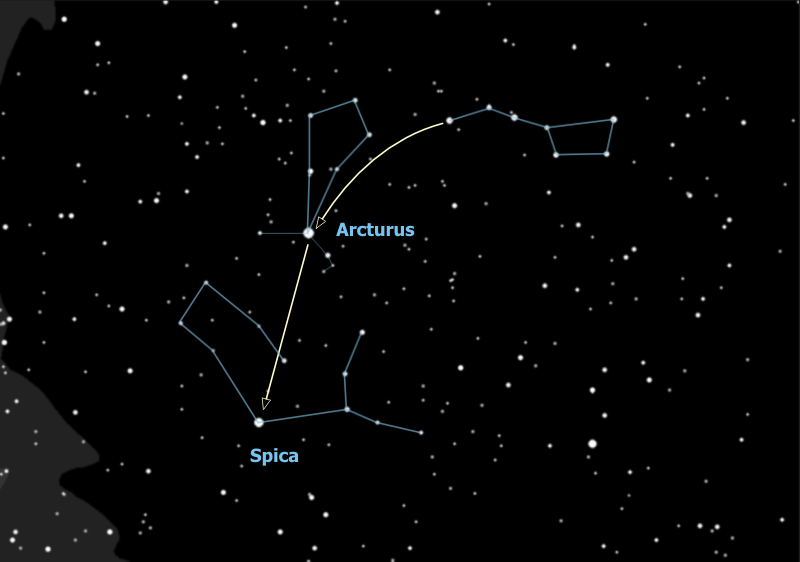
- Wait a minute is that really three stars in the Dipper's handle or is it
four? Looky there the middle star seems to have a companion -- the bright
star is Mizar and the companion is Alcor. Who can see the companion?
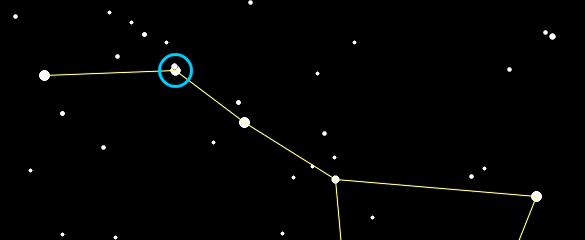
That was used by ancient Greek and Arab armies as an eye test. Some see them as a horse & rider. The Europeans saw the handle of the dipper as the tail of the Great Bear. Since bears don't have tails they danced around it by explaining that when the gods lifted the bear to the sky the tail got stretched out. Pretty lame. The Indians, who knew darn right well that bears don't have tails, saw the three stars of the handle as hunters chasing the great bear (interesting that they also saw a bear). When the constellation Ursa Major sets in the fall, the Indians explained that the hunters catch up with him and shoot him with their arrows, which is why the leaves on the trees turn red. Anyway the three stars are hunters and one of them brought his dog, so Mizar is a hunter and Alcor is his dog. Or another story is that there are three hunters pursuing the bear and one brought a pot to cook the bear in (optimistic). So Mizar is a hunter and Alcor is his pot. Yet another story involves the Pleiades. This is a star cluster in the constellation Taurus (a winter constellation). It is called "the Seven Sisters" and those with very sharp eyes can see seven stars but most people can only see six. So the story is that Mizar is riding off with the Seventh Sister.
But wait there's more! When we put the telescope on these two you'll see that Mizar is really a double star itself! So these three form a triple star. But wait... that's right... there's MORE! In reality each of the two stars that make up Mizar is a double star, too close for us to see even with a big telescope, and for that matter, so is Alcor! So Mizar & Alcor comprise a SIX STAR SYSTEM!!
 |
 |
 |
| Back to Stargazing | Go to Summer Index | On to Bootes |
Questions
Your questions and comments regarding the Stargazing section are welcome.
You can e-mail the author, Randy Culp for inquiries,
suggestions, new ideas or just to chat.
Updated 09 August 2020
